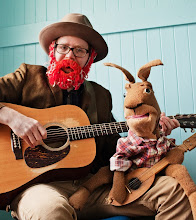It's been too long since my last post! Much has happened between April and September. As far as Red Yarn is concerned, the most important development is the creation of the Red Yarn Puppet Band. If you have followed this blog, you'll know that I've been dreaming up an Epic American Animal Folk Puppet Musical. But, given the scope of my visions, it's been difficult to realize them. Back in the spring, I decided that making stop motion videos would be the easiest way. Well, have you ever tried making stop motion videos?? IT'S NOT EASY!! And more importantly, it can be a pretty isolating process. I decided that rather than hole up in a dark closet for the next year, manipulating small puppets frame by frame, I wanted to take this project to the streets, to build community around creativity, puppetry, and folk music.
So, back in July, I put out an email to many of my creative friends in Portland to see if anyone would be interested in starting a musical puppet troupe. I had just enough takers--my old friend Jim would find time in his busy med school schedule to play banjo and try his hand at making puppets; my new friend Tony, who used to work at Laika (the stop motion movie studio that made
Coraline), would build and operate puppets; my friend Nina, who is a master knitter, would knit and sew little creatures in her free time; finally, my fiancee Jessie got enlisted in to sing, craft, and handle puppets (a generous contribution of time and talent considering that she is starting an intense new job as a middle school teacher!). The Red Yarn Puppet Band was born!
I introduced the group to some of my favorite animal folk songs--"Mr. Rabbit," "Raccoon's Got a Bushy Tail," "Who Killed Cock Robin," "Froggie Went A'Courtin'." Everyone chose a character and we started building puppets (mostly with materials from SCRAP, an amazing craft store/educational organization that specializes in recycled art supplies). Jim worked on Uncle Rat; Tony built Mr. Raccoon; Nina worked on a snake and a nest full of baby birds; Jessie made Ms. Mousie; I finished a possum puppet and started working on Froggie. After a month of work, we had a large cast of characters to animate many of these old American animal songs. Jessie, Jim and I arranged the songs with guitar, banjo, and three-part harmonies.
We had our first show on Saturday at the Slabtown Community Festival in Northwest Portland. It was a huge success! We led a parade of costumed kids from a nearby park to the festival site. Tony and I played drums marching band style. Jessie and Tony's partner Stef worked puppets and led chants. Once at the festival site, we played a set for a great crowd of children and families.

We wove six old songs into a narrative about our hero, Bob Rabbit, traveling through the Deep Woods looking for adventure. I played guitar, sang, and narrated as Mr. Sun, looking down on all the action and interacting with the other characters. Jim played banjo and sang.

Jessie sang and operated Bob Rabbit, Mr. Mousie, and Snake.


Tony kept his hands full with Farmer John, Froggie, Uncle Rat, Mr. Raccoon, and Mr. Possum.


Stef made a rousing cameo appearance as the cat that chases Froggie's and Mousie's wedding party into the lake.

We received great feedback from the kids and parents watching. "I loved the dark Appalachian sound!" "Way to weave the theme of death into a kids' show!" "You guys are going to be as big as Raffi!" (Is that a compliment?) It was a wonderful inaugural show and got me very excited for the future of the Red Yarn Puppet Band. It feels so good to be working with a group of such creative people. They bring talents and ideas to this project that I could never achieve on my own. And they have imbued their puppets with amazing personality that brings new color to these songs and stories.
Our next project is building several puppets--one large-scale and four hand-and-rod or stick puppets--for a friend's CD release show in two weeks. If you are in Portland, come to the Pancake Breakfast CD Release at the Doug Fir on September 25. I'll post pictures after the show.
Hurray for community! Hurray for the Red Yarn Puppet Band!

































